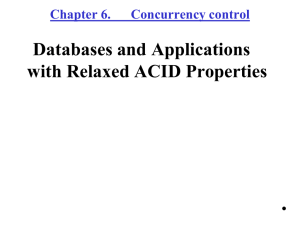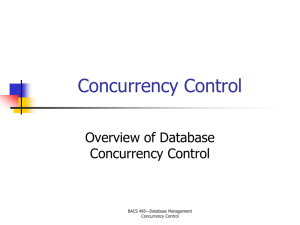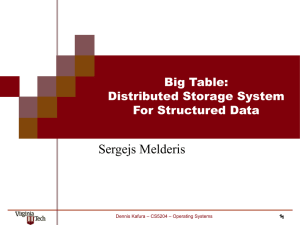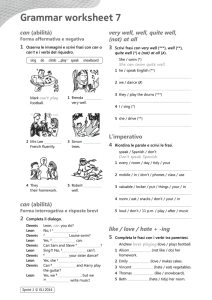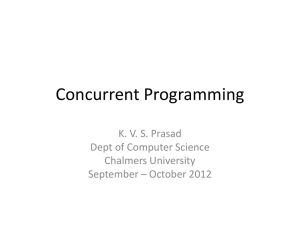Concurrency Issues
advertisement
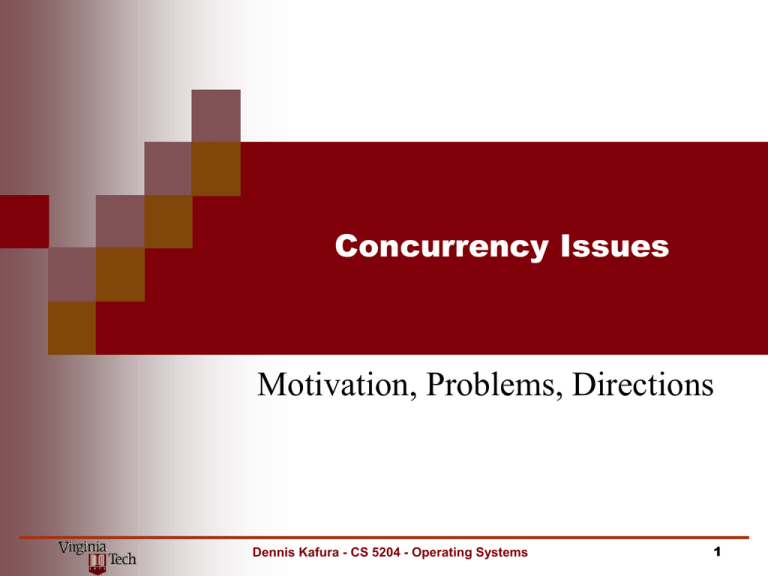
Concurrency Issues Motivation, Problems, Directions Dennis Kafura - CS 5204 - Operating Systems 1 Concurrency Issues Reasons for Concurrency coordination multitasking parallelism performance Dennis Kafura - CS 5204 - Operating Systems 2 Concurrency Issues Moore’s Law “Transistor density on integrated circuits doubles about every two years.” Gordon E. Moore, Co-founder, Intel Corporation. Dennis Kafura - CS 5204 - Operating Systems 3 Concurrency Issues Hitting the wall… Dennis Kafura - CS 5204 - Operating Systems 4 Concurrency Issues Thermal Density 2005 (cooler alone) 1993 (CPU and cooler) Dennis Kafura - CS 5204 - Operating Systems 5 Concurrency Issues Rise of Multi-/Many- Core Technologies Intel: Quad Core Intel: 80 core experimental system Sun: 8 core chip Dennis Kafura - CS 5204 - Operating Systems 6 Concurrency Issues Context concurrent parallel Support for concurrent and parallel programming conform to application semantics functionality respect priorities of applications no unnecessary blocking fast context switch high processor utilization performance relative importance Dennis Kafura - CS 5204 - Operating Systems 7 Concurrency Issues “Heavyweight” Process Model ... user kernel • simple, uni-threaded model • security provided by address space boundaries • high cost for context switch • coarse granularity limits degree of concurrency Dennis Kafura - CS 5204 - Operating Systems 8 Concurrency Issues “Lightweight” (User-level) Threads ... user kernel • thread semantics defined by application • fast context switch time (within an order of magnitude of procedure call time) • system scheduler unaware of user thread priorities • unnecessary blocking (I/O, page faults, etc.) • processor under-utilization Dennis Kafura - CS 5204 - Operating Systems 9 Concurrency Issues Kernel-level Threads ... user kernel • thread semantics defined by system • overhead incurred due to overly general implementation and cost of kernel traps for thread operations • context switch time better than process switch time by an order of magnitude, but an order of magnitude worse than user-level threads • system scheduler unaware of user thread state (e.g, in a critical region) leading to blocking and lower processor utilization Dennis Kafura - CS 5204 - Operating Systems 10 Concurrency Issues Threads are Bad Difficult to program Synchronizing access to shared state Deadlock Hard to debug (race conditions, repeatability) Break abstractions Modules must be designed “thread safe” Difficult to achieve good performance simple locking lowers concurrency context switching costs OS support inconsistent semantics and tools vary across platforms/systems May not be right model Window events do not map to threads but to events Dennis Kafura - CS 5204 - Operating Systems 11 Concurrency Issues Lee’s Crticisms of Threads Threads are not composable Difficult to reason about threads Everything can change between steps Threads are “wildly nondeterministic” Inteference via shared resources Requires careful “pruning” by programmer In practice, difficult to program correctly Experience and examples Dennis Kafura - CS 5204 - Operating Systems 12 Concurrency Issues Ousterhout’s conclusions Dennis Kafura - CS 5204 - Operating Systems 13 Concurrency Issues Resilience of Threads Widely supported in mainstream operating systems Direct kernel/hardware support even if semantics differ via kernel threads and multi-core shared address spaces Ability to pass complex data structures efficiently via pointers in shared memory Programmability standard interfaces defined (e.g., POSIX) construct in some languages (e.g., Java) widely delolyed/understood (even if misused) Dennis Kafura - CS 5204 - Operating Systems 14 Concurrency Issues Concurrency Errors in Practice Characterization study Four large, mature, open-source systems 105 randomly selected currency errors Examined bug report, code, corrections Classified bug patterns, manifestation, fix strategy Dennis Kafura - CS 5204 - Operating Systems 15 Concurrency Issues Concurrency Error Patterns Finding (1): Most (72 out of 74) of the examined non-deadlock concurrency bugs are covered by two simple patters: atomicity-violation and order-violation. A B atomicity-violation: interference with a sequence of steps intended to be performed as a unit order-violation: failure to perform steps in the intended order Dennis Kafura - CS 5204 - Operating Systems 16 Concurrency Issues Concurrency Bug Manifestations Finding (3): The manifestation of most (101 out of 105) examined concurrency bugs involves no more than two threads. Other findings: most (66%) non-deadlock concurrency bugs involved only one variable and most (97%) of deadlock concurrency bugs involves at most two resources.. Dennis Kafura - CS 5204 - Operating Systems 17 Concurrency Issues Concurrency Bug Fix Strategies Finding (9): Adding or changing locks is not the major fix strategy. COND: Condition check Design: algorithm change Switch: Code switch Lock: add or change lock Another finding: transactional memory (TM) can help avoid many (41 or 105) concurrency bugs. Dennis Kafura - CS 5204 - Operating Systems 18 Concurrency Issues Solutions to thread problems New models of concurrent computation MapReduce Large-scale data Highly distributed, massively parallel environment Concurrent Collections (CnC) General concurrent programming vehicle Multicore architectures Thread-per-process models Communicating Sequential Processes Grace Sammati Dennis Kafura - CS 5204 - Operating Systems 19




